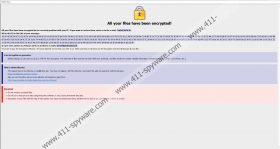TorS@Tuta.Io Ransomware Removal Guide
When TorS@Tuta.Io Ransomware successfully invades a Windows operating system, it encrypts files. It encrypts documents, videos, projects, photos, and other personal files as well as system files. This is not very common for file encryptors because when system files are corrupted, the system might stop working properly, and this could make it impossible for the attackers to present a ransom note. Ransomware, after all, is the kind of malware that takes hostages to validate a ransom request. Our research team has analyzed the ransom note introduced by the cybercriminals behind this infection, but we do not know if all victims will get to do the same. At the end of the day, we do not recommend paying attention to any demands or instructions anyway, and so it does not matter whether you can access the file. That being said, if the threat encrypts everything, you might have no other choice but to reinstall Windows. In either case, deleting TorS@Tuta.Io Ransomware is important.
GlobeImposter Ransomware is the predecessor of C4H Ransomware, Taargo Ransomware, as well as the malicious TorS@Tuta.Io Ransomware. These threats are likely to use spam emails and bundled downloaders to slither in stealthily, and unpatched vulnerabilities could be exploited too. The goal of the distributor is to ensure that you do not realize that you are executing a malicious file. Therefore, it could be introduced as a harmless-looking email attachment or be disguised as a seemingly familiar program. If the person executing the malicious file does not have their system protected reliably, TorS@Tuta.Io Ransomware might slither in without notice. If reliable security software is implemented, this malware should be caught and removed before execution. Unfortunately, there are still many Windows users around the world who are not taking care of their systems’ security appropriately, and that is why cybercriminals are exploiting file-encrypting ransomware successfully. Unfortunately, once a threat is executed, it encrypts files right away, after which, not much can be done.
When TorS@Tuta.Io Ransomware encrypts files, it adds the “.[TorS@Tuta.Io]” extension to their names as a marker. It also places a copy of a file named “Help Restore.hta” next to them. If the system does not crash after the attack of the infection, victims can open this file and find a message from the attackers. It declares that as soon as an email is sent to ToRs@TuTa.Io (or torsed@protonmail.ch) and then a ransom is paid, victims can have their files decrypted. Even if you feel backed into a corner, you should not give into the demands of cybercriminals. Remember that they can tell you anything just so that you would help them reach their goals. Needless to say, cybercriminals created this particular infection for one goal only, and that is to take your money. If you have communicated with them already, please be cautious about the messages that they might send. Note that new email addresses could be used, and the attackers could use the bridge to expose you to new malicious threats or scams.
If your Windows operating system is not running properly, you might have no other option but to reinstall it. You can do that in several different ways, and you should look up instructions depending on the version of your system also. After this, you will not need to remove TorS@Tuta.Io Ransomware because it will be gone along with all of the encrypted personal files. If you do not want to lose them, move them to an external drive or to cloud storage before reinstalling Windows, if that is possible. There is a free tool named ‘GlobeImposter Decryptor,’ and we hope that it will help the victims of TorS@Tuta.Io Ransomware also, but we cannot guarantee it. Another option is to use backups to replace the lost files, which, of course, is possible only if backups exist. In the future, always store copies of important files in a safe location. Also, do not forget to implement trusted anti-malware software because it might be the only barrier protecting you against ransomware and other types of malware.
How to delete TorS@Tuta.Io Ransomware
- Delete the ransom note file, Help Restore.hta.
- Delete recently downloaded suspicious filesfrom:
- %USERPROFILE%\Desktop
- %USERPROFILE%\Downloads
- %TEMP%
- Empty Recycle Bin.
- Install a trusted malware scanner and run a system scan.
- If you need to, reinstall Windows.
TorS@Tuta.Io Ransomware Screenshots:


